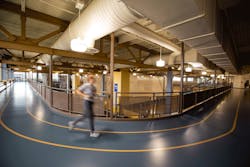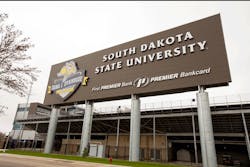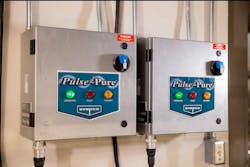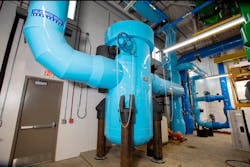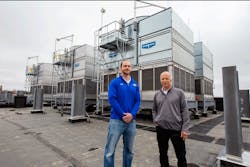South Dakota State University Expands With New Chiller Plant
Case Study by EVAPCO
South Dakota’s beauty and significance is often betrayed by its lack of mentions in the national news. Largely comprised of rolling prairie, pothole lakes and crystal clear streams, South Dakota is host to many natural wonders and historically significant landmarks.
The Mount Rushmore State is bookended by its two largest population centers. Rapid City lies to the west, near the iconic Black Hills and Badlands National Park, while Sioux Falls, in the southeast, is just minutes from the Minnesota and Iowa borders.
Like many Western states, South Dakota has grown significantly in recent years. Its expansion has been outpaced by the growth of its largest educational institution, South Dakota State University in Brookings, just north of Sioux Falls.
The new wellness center was among the facilities that required more cooling.
SDSU is best known for its agriculture, pharmaceutical and nursing colleges. It now boasts roughly 12,500 students. More than one million square feet of educational space has been added over the past decade, due in part to the burgeoning need for on-campus research.
“The university’s recent physical plant growth has been a combination of student housing and research facilities from all colleges,” said SDSU Senior Mechanical Engineer, Zachary Rykhus. “The Ag College is in the process of significant expansion. Two research buildings are currently under construction.”
Engineer Rykhus has immersed himself in the new high-end chiller plant controls.
Rather than simply keeping pace with the flourishing student body, leadership at SDSU had the foresight to plan for future expansion.
Cooling System Expansion
“We responded to a request for qualifications issued by the South Dakota Office of the State Engineer in August of 2012,” said Greg Kronaizl, Executive VP at Farris Engineering Inc. “The university’s existing chiller plant wasn’t sufficient for the expansions they had planned and were already implementing.”
Based in Omaha, Farris Engineering is a full-service MEP and fire protection design and engineering consultancy with four offices in Nebraska and Colorado. Founded in 1967 and now employee-owned, the 60-person company operates largely in the lower 48, occasionally pursuing projects abroad. The commercial, government and higher education sectors make up the bulk of their work.
A wellness center, a new football stadium, and three new agricultural buildings were recently constructed, or soon would be. Among them, Raven Precision Agriculture Center offers data analytics, soil sciences, precision crop production, plant pathology, mapping, precision farm machinery, and weed/pest control management among other related technologies. All told, there was a need for more than 4,000 tons of cooling.
“Based on construction schedules, half of that load was needed quickly,” said Kronaizl. “The new plant was designed with the understanding that construction would take place in two phases, separated by several years. We provided a utilities master plan and distribution of steam and cooling lines throughout the campus in addition to the plant design.”
Unexpected donor funding accelerated the schedule for connecting the football stadium to the new chiller plant.
“Careful component selection resulted in a 30 percent reduction in labor cost,” he continued. “This allowed the project to move forward with the cooling capacity needed and inclusion of high-end chiller plant controls. In addition, chemical treatment of condenser water was avoided altogether.”
Minimizing Water Consumption
By May of 2015, engineering work had culminated and the construction of Phase One began.
“One overarching theme throughout this project was to minimize wastewater,” said Kronaizl. “A good first step was to elevate the cooling towers, eliminating a great deal of the [agricultural] dust that would have otherwise settled inside and atop the cooling towers, and generally making service of all outdoor equipment easier.”
Agricultural facilities occupy the northwest corner of the campus. Crop production studies in adjacent fields create dust at various times of the year.
During phase one, Sioux Falls, SD-based Midwestern Mechanical Inc. installed three, two-cell EVAPCO AT counterflow cooling towers made of 304/304L stainless steel. The towers were supplied by EVAPCO’s rep firm G&R Controls, also based in Sioux Falls. The units provide 2,250 tons of combined cooling capacity. Six, 750-ton Trane electric-driven centrifugal water chillers are installed in the chiller plant building below the towers. The facility also includes a free-cooling heat exchanger for winter cooling operation equivalent to approximately 1,000 tons.
The use of plastic pipe helped reduce the amount of wastewater produced, while non-chemical treatment solutions reduced the environmental impact.
Two other elements, non-chemical treatment solutions and the use of plastic pipe, helped reduce the amount of wastewater produced by the cooling systems and eliminate the associated cost and environmental impact of chemical treatment.
Alternative Water Treatment
“Water quality in Brookings is okay for cooling tower applications; not great but not horrible,” said Brandon Punt, sales manager at Jaytech Inc., one of the nation’s largest water management solutions providers. “Hardness and alkalinity are two concerns with source water, while microbial growth will result from atmospheric exposure if water treatment isn’t handled properly.”
The mechanical system design specified use of EVAPCO’s Pulse~Pure non-chemical water treatment system for the condenser water. This technology uses pulsed electrical fields to solve all three critical water treatment challenges typical of open-loop cooling systems: scale, corrosion and microbiological activity.
In a Pulse~Pure system, recirculated water from the evaporative cooling system passes through the pulse chamber where it’s exposed to alternating high and low frequency electric fields. This impacts both the surface charge of small suspended particles and free-floating microbial organisms found in cooling water.
“The school was seeking a net zero discharge for sustainability reasons,” said Kronaizl. “Conserving water was equally important as avoiding chemical use. We’ve used Pulse~Pure successfully on smaller projects in the past. When we installed it at six district plants for the Lincoln District Energy Corporation, the factory support was very good, so we didn’t have any hesitation to use it on a bigger job. We also took other steps to minimize the water treatment capacity needed at SDSU.”
Innovative Piping Solution
Instead of piping the cooling system with steel, plastic pipe was used throughout. ISCO Industries' HDPE pipe was used for all underground chilled water lines, while PP-RCT (polypropylene) was used for all condenser water piping within the cooling plant itself.
The non-chemical water treatment system for the condenser water uses pulsed electrical fields to manage scale, corrosion and microbiological activity.
“The first benefit of using plastic pipe is that it greatly reduces the amount of metal surfaces that cooling system fluid comes in contact with,” explained Kronaizl. “The second benefit was a 30 percent reduction in labor cost compared to steel pipe. Lighter material is simply easier, faster and safer to handle.”
Accelerated Schedule and Optimal Control
Initially, the football stadium was considered a future potential connection to the new chiller plant, as it was located on the east side of main campus and currently using remote chillers. When donor funding became available, the schedule was accelerated.
Six, 750-ton electric-driven centrifugal water chillers are installed in the new plant building below the cooling towers.
The university decided to fast-track integration of the stadium with the new chiller plant. Seating 19,340 fans, the Dana J. Dykhouse Stadium is home to the SDSU Jackrabbits.
“This created a shift in priorities,” said Kronaizl. “Plant construction was accelerated, and the installation of chilled water lines to the stadium took precedence over providing chiller plant capacity to other buildings.”
The university wanted remote access and fully automated controls at the new chiller plant. Johnson Controls’ Metasys-powered Central Plant Optimization 10 was installed. This system permits interface between any brand of equipment and the JCI Metasys architecture; it uses PID feedback control, setpoint adjustments, and provides efficiency curves for plant optimization.
“The facility’s layout and design are as conducive as any as far as operating and maintaining the plant is concerned,” said Rykhus. “The plant is almost entirely automated so it does not require anyone to be on-site during normal operation.”
Rykhus and Barry Neilson (right) of G&R Controls are overseeing the last of two multi-year phases of the chiller plant installation, set to wrap up this fall.
Final Phase
Farris Engineering designed Phase Two as an exact mirror image of phase one, again, using Pulse~Pure as the sole form of water treatment. Three more, identical cooling towers are to be installed over the summer of 2019, bringing the total cooling capacity of the chiller plant to 4,500 tons.
Phase one was operational in August 2016, serving the stadium and a variety of other buildings. Phase Two, when complete in October 2019, will provide cooling capacity to a 60,000 square-foot Animal Disease Research addition and future Precision Ag facility.
Krier & Blain, a large mechanical firm out of Sioux Falls, was contracted to install the second phase of the chiller plant. Roughly two years passed between the two projects, giving managers time to assess the performance of the new system’s installed components so the design could have been changed, if needed.
The only change made to the original design was cancelling the installation of a screen wall around the chiller plant for aesthetic reasons. The university was initially concerned that the cooling towers would be an eyesore. This was not the case.
“I conducted a full cooling tower inspection last time I was at SDSU,” said Punt. “The towers were extremely clean.”
Despite the addition of the new football stadium, installation of the new chiller plant proceeded as scheduled, and all components of the system met the university’s expectations. SDSU’s new expansion is proof that adding infrastructure does not need to increase environmental impact.

